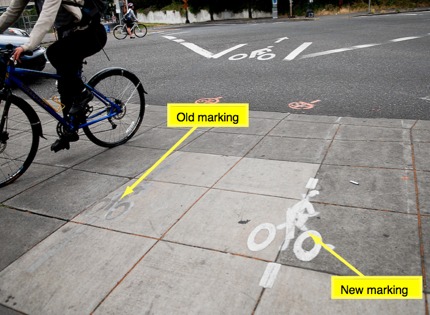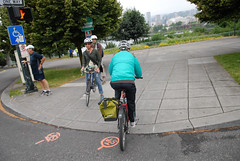
(Photos © J. Maus)
When I wrote a story about a series of annoyingly jarring, and sometimes injury-causing bumps on the Eastbank Esplanade ramps earlier this month, many people felt it was just unecessary whining. “We have much more important issues to deal with!”, “This is why people think cyclists have such a bad reputation of entitlement!”, “Stop whining and just deal with it!” were common sentiments expressed in the comments.
The Portland Parks bureau heard about the issue and, while the bumps will remain for now, they are looking into improved signage to warn of the bumps’ presence and make them more visible to people on bikes.
Given the tone of feedback and comments I received after reporting on that issue, I was quite interested to notice that the Portland Bureau of Transportation recently addressed a similar issue just a bit north of the Esplanade ramps. I think it makes for an interesting comparison.
“It was awkward, a little bit of a nuisance, and this is one really inexpensive thing that might make it better.”
— Jeff Smith, PBOT
A few weeks ago, crews shifted the location of a bike signal sensor loop marking (see photo at top of story). The problem (which was well-known to people who use that route regularly) is that people headed north would wait for the light over the old pavement marking. Unfortunately, the marking was smack dab in the middle of the curb ramp where bike traffic coming in the opposite direction needed to go. This caused a bit of a snafu because there wasn’t much room to pass.
Even though there were no reports of injuries or collisions and there are certainly more pressing issues to address in our bikeway network, this seemingly minor annoyance somehow merited attention and a fix by PBOT. The marking has been moved a few feet to the right (don’t worry, it still triggers the signal).
Jeff Smith, the PBOT staffer who managed the project, said they’d heard about the issue from several sources before deciding to move the marking. “It [the location of the marking] was awkward… a little bit of a nuisance, and this is one really inexpensive thing that might make it better.”
Making these types of refinements may seem trivial, but when small annoyances accumulate, they can have a negative impact on someone’s decision to consider riding a bicycle over other modes (as we learned with our guest article about tolerance). In my opinion, going through our existing network with a fine-toothed comb to fix these small problems would seem to be a prudent investment.


